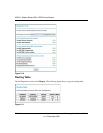
ADSL2+ Modem Router DM111PSPv2 User Manual
3-6 Security and Firewall Protection
v1.0, December 2008
Create a new inbound IP filtering rule, and then click Apply to add the rule to the inbound traffic
rules table in the Firewall Rules screen (see
Figure 3-1 on page 3-3). Table 3-1 describes the
settings on the Add New Inbound IP Filtering Rule screen.
Port Forwarding (Inbound Rules)
Because the modem router uses Network Address Translation (NAT), your network presents only
one IP address to the Internet, and outside users cannot directly address any of your local
computers. However, by defining an inbound rule you can make a local server (for example, a Web
server or game server) visible and available to the Internet.
The inbound rule that you create tells the modem router to direct inbound traffic for a particular
service to one local server based on the destination port number. This is also known as port
forwarding.
Table 3-2. Inbound IP Filtering Rule Settings
Settings Description
Allow Traffic Select a radio button
• Yes. The new rule is used to allow inbound traffic.
• No. The new rule is used to prevent inbound traffic
Protocol Make a selection from the drop-down list:
• TCP. The rule applies to Transmission Control Protocol (TCP) traffic.
• UDP. The rule applies to User Datagram Protocol (UDP) traffic.
• ICMP. The rule applies to Internet Control Message Protocol (ICMP) traffic.
• AH. The rule applies to Authentication Header (AH) protocol traffic.
• ESP. The rule applies to Encapsulating Security Payload (ESP) traffic.
• GRE. The rule applies to Generic Route Encapsulation (GRE) traffic.
• ALL. The rule applies to all protocol traffic.
• User Defined. Enter a protocol name in the “as” field.
Source IP Address Make a selection from the drop-down list:
• ALL. The rule applies to all source IP addresses.
• SINGLE. Enter the source IP address in the “IP addr.” field.
• SUBNET. Enter the source IP address in the “IP addr.” field and the subnet
address in the “NetMask” field.
Destination IP Address Make a selection from the drop-down list:
• ALL. The rule applies to all destination IP addresses.
• SINGLE. Enter the destination IP address in the “IP addr.” field.
• SUBNET. Enter the destination IP address in the “IP addr.” field and the subnet
address in the “NetMask” field.
Port Range You can specify a port range only when TCP, UDP, or User Defined is selected
from the Protocol drop-down list. Enter the start port for the port range in the
“Start” field and enter the end port for the port range in the “End” field.


















